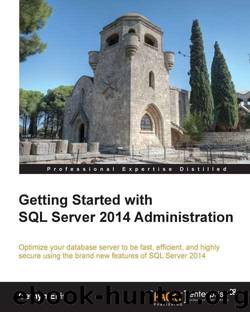Getting Started with SQL Server 2014 Administration by 2014

Author:2014
Language: eng
Format: mobi
Publisher: Packt Publishing
This code returns the name and location of the DLLs currently loaded into memory as can be seen in the following screenshot:
The name of the DLL is prefixed with xtp and then a t or p depending on whether it is a stored procedure or table. In-Memory OLTP tables get compiled too and then derived from database_id and object_id.
Concurrency
Concurrency is the term used to describe how a database system such as SQL Server 2014 deals with multiple concurrent users. It is needed to ensure that when one person makes changes to the data, those changes do not adversely affect those of another user. This is sometime called concurrency control.
There are two types of concurrency control:
Pessimistic concurrency control: A system-implemented locking system prevents users from changing data that affects other users. When a user performs an action, it causes a lock to be applied. The other users cannot perform any action that would conflict with that lock until that lock is released.
Optimistic concurrency control: When reading data, users do not put locks on data. When a user makes changes to the data, the system checks if another user changed the data after it was read. If the data was changed, an error is raised.
SQL Server supports a range of concurrency control. Users specify the type of concurrency control by selecting transaction isolation levels for connections or concurrency options for cursors.
Download
This site does not store any files on its server. We only index and link to content provided by other sites. Please contact the content providers to delete copyright contents if any and email us, we'll remove relevant links or contents immediately.
Sass and Compass in Action by Wynn Netherland Nathan Weizenbaum Chris Eppstein Brandon Mathis(13266)
Implementing Enterprise Observability for Success by Manisha Agrawal and Karun Krishnannair(8233)
Supercharging Productivity with Trello by Brittany Joiner(7481)
Mastering Tableau 2023 - Fourth Edition by Marleen Meier(7231)
Inkscape by Example by István Szép(7121)
Visualize Complex Processes with Microsoft Visio by David J Parker & Šenaj Lelić(6803)
Build Stunning Real-time VFX with Unreal Engine 5 by Hrishikesh Andurlekar(5830)
Design Made Easy with Inkscape by Christopher Rogers(5088)
Customizing Microsoft Teams by Gopi Kondameda(4635)
Business Intelligence Career Master Plan by Eduardo Chavez & Danny Moncada(4589)
Extending Microsoft Power Apps with Power Apps Component Framework by Danish Naglekar(4226)
Salesforce Platform Enterprise Architecture - Fourth Edition by Andrew Fawcett(4112)
Pandas Cookbook by Theodore Petrou(4087)
Linux Device Driver Development Cookbook by Rodolfo Giometti(4052)
The Tableau Workshop by Sumit Gupta Sylvester Pinto Shweta Sankhe-Savale JC Gillet and Kenneth Michael Cherven(3890)
Exploring Microsoft Excel's Hidden Treasures by David Ringstrom(3392)
TCP IP by Todd Lammle(3155)
Applied Predictive Modeling by Max Kuhn & Kjell Johnson(3041)
Drawing Shortcuts: Developing Quick Drawing Skills Using Today's Technology by Leggitt Jim(3037)
